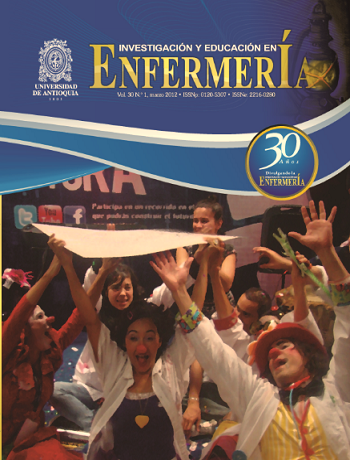Risk factors for complications in large for gestational age newborns.
DOI:
https://doi.org/10.17533/udea.iee.8687Keywords:
Risk factors; infant, newborn; gestational age; pregnancy complications; obstetric labor complications.Abstract
Objective. To explore the relationship between risk factors originated from the mother, labor and the newborn, with the risk of complications in the newborn large for gestational age.
Methodology. Analytical study of 170 cases of newborns large for gestational age (LGA), and 260 controls with appropriate weight for gestational age (AGA). Strength of association was estimated through the OR with its respective confidence intervals of 95%. Statistical significance was assumed when the probability value of the studied relationship was under 0.05.
Results 40.0% of the cases versus 13.1% of controls had any kind of complication. for an OR of 4.4 (CI95%: 2.7-7.1), prevailing congenital malformations, hypoglycemia and respiratory complications. Statistical significant correlation of the studied condition (LGA) with male sex was found.
Conclusion. Regarding children AGA, newborns LGA had a higher probability of complications, especially congenital malformations, respiratory and metabolic complication.
Downloads
References
(1) Boulet SL, Alexander GR, Salihu HM, Pass MA. Macrosomic births in the United States: Determinants, outcomes and proposed grades of risk. Am J Obstet Gynecol. 2003; 188(5):1372-8.
(2) Jason A, Donald D, Brian M, Casey KJ. Predicting Macrosomia. J Ultrasound Med. 2008;27(1):39-43
(3) Johnson JW, Longmate JA. Excessive maternal weight and pregnancy outcome. Ann Fam Med. 2008;6(6):482.
(4) Cruz J, Hernández P, Yanes M, Rimbao G, Lang J Márquez A. Macrosomía neonatal en el embarazo complicado con diabetes. Rev Cubana Med Gen Integr [Internet]. 2008 [acceso 15 de diciembre de 2010]; 24(3):. Disponible en: http://scielo.sld.cu/scielo.php?script=sci_arttext&pid=S0864-21252008000300006&lng=es .
(5) Ballesté I, Alonso RM. Factores de riesgo del recién nacido macrosómico. Rev Cubana Pediatr. 2004; 76(1):33-7.
(6) Hirnle L, Kowalska M, Petrus A, Hirnle G, Zimmer M. The analysis of risk factors for fetal macrosomia and the complications in the course of pregnancy and delivery of macrosomic baby. Ginekol Pol. 2007;78(4):280-3.
(7) D. Sadeh-Mestechkin A, Walfisch R, Shachar I, Shoham-Vardi I, Vardi H, Hallak M. Suspected macrosomy? Better not tell. Arch Gynecol Obstet. 2008;278(3):225-30.
(8) Molina OR, Monteagudo CL. Caracterización perinatal del recién nacido macrosómico. Rev Cubana Obstet Ginecol. 2010; 36(3): 313-21.
(9) Enríquez JO, León C, González N, Marrero L, Águila. O Cambios antropométricos durante el primer año de vida en niños nacidos con bajo peso y peso adecuado para la edad gestacional. Rev Cubana Aliment Nutr. 2000;14(1):39-45
(10) Yaakov D, Ohel I, Levy A, Gershon H, Eyal S, Lack of prenatal care: an independent risk factor for perinatal mortality among macrosomic newborns. Arch Gynecol Obstet. 2008;277(6):511-4.
(11) Batallan A, Goffinet F, Paris-Llado J, Fortin A, Bréart G, Madelenat P, Bénifla JL; Groupe d’étude des maternités parisiennes. Fetal macrosomia: management, obstetrical and neonatal results. Multicenter case-control study in 15 maternity hospitals in Paris and the Ile de France area Gynecol Obstet Fertil. 2002;30(6):483-91.
(12) Lim JH, Tan BC, Jammal AE, Symonds EM. Delivery of macrosomic babies: management and outcomes of 330 cases. J Obstet Gynaecol. 2002;22(4):370-4.
(13) Voldner N, Qvistad E, Frey K, Godang K, Tore H, Bollerlev J. Increased risk of macrosomia among overweight women with high gestational rise in fasting glucose. J Matern Fetal Neonatal Med. 2010 Jan;23(1):74-81.
(14) Mazouni, C., Rouzier, R., Ledu, R., Heckenroth, H., Guidicelli, B. and Gamerre, M. (2007), Development and internal validation of a nomogram to predict macrosomia. Ultrasound in Obstetrics & Gynecology, 29: 544–549.
(15) Mehta SH, Blackwell SC, Bujold E, Sokol RJ. What factors are associated with neonatal injury following shoulder dystocia? J Perinatol. 2006 Feb; 26(2):85-8.
(16) Ehrenstein V, Pedersen L, Grijota M, Nielsen GL, Rothman KJ, Sørensen HT. Pregnancy Childbirth. Association of Apgar score at five minutes with long-term neurologic disability and cognitive function in a prevalence study of Danish conscripts. Diabetes Metab Res Rev. 2007 Sep;23(6):485-9.
(17) Stotland NE, Caughey AB, Breed EM, Escobar GJ. Risk factors and obstetric complications associated with macrosomia. Int J Gynaecol Obstet 2005; 87: 220–226.
(18) 18 Poggi SH, Ghidini A, Allen RH, Pezzullo JC, Rosenbaum TC, Spong CY. ffect of operative vaginal delivery on the outcome of permanent brachial plexus injury. J Reprod Med. 2003 Sep;48(9):692-6.
(19) Trindade LL, Amestoy SC, Picolo D, Falchetti G, Milbrath VM. Fatores de risco para morte fetal no município de Pato Branco (Brasil). Invest Educ Enferm. 2011;29(3):451-8.
(20) Ju H, Chadha Y, Donovan T, O’rourke P. Fetal macrosomia and pregnancy outcomes. Aust N Z J Obstet Gynaecol. 2009 Oct;49(5):504-9.
(21) Tam WH, Yang XL, Chan JC, Ko GT, Tong PC. Progression to impaired glucose regulation, diabetes and metabolic syndrome in Chinese women with a past history of gestational diabetes. Diabetes Metab Res Rev. 2007 Sep;23(6):485-9.
Downloads
Published
Versions
- 2025-01-22 (2)
- 2012-04-10 (1)
How to Cite
Issue
Section
License

This work is licensed under a Creative Commons Attribution-NonCommercial-ShareAlike 4.0 International License.
Derechos de propiedad / Direitos de Propriedade
English: If the article is accepted for publication, all copyright will be of exclusive property of Investigación y Educación en Enfermería. The text and the graphics included in the publication are exclusive responsibility of the authors and not necessarily reflect the thought of the Editorial Committee.
Español: Si el artículo es aprobado para publicación, todos los derechos son de propiedad de Investigación y Educación en Enfermería. El texto y las gráficas incluidas en la publicación son de exclusiva responsabilidad de los autores y no necesariamente refleja el pensamiento del Comité Editorial.
Português: Se o artigo for aceito para publicação, todos os direitos autorais serão de propriedade exclusiva de Investigación y Educación en Enfermería. O texto e os gráficos incluídos na publicação são de responsabilidade exclusiva dos autores e não refletem necessariamente o pensamento do Comitê Editorial.















